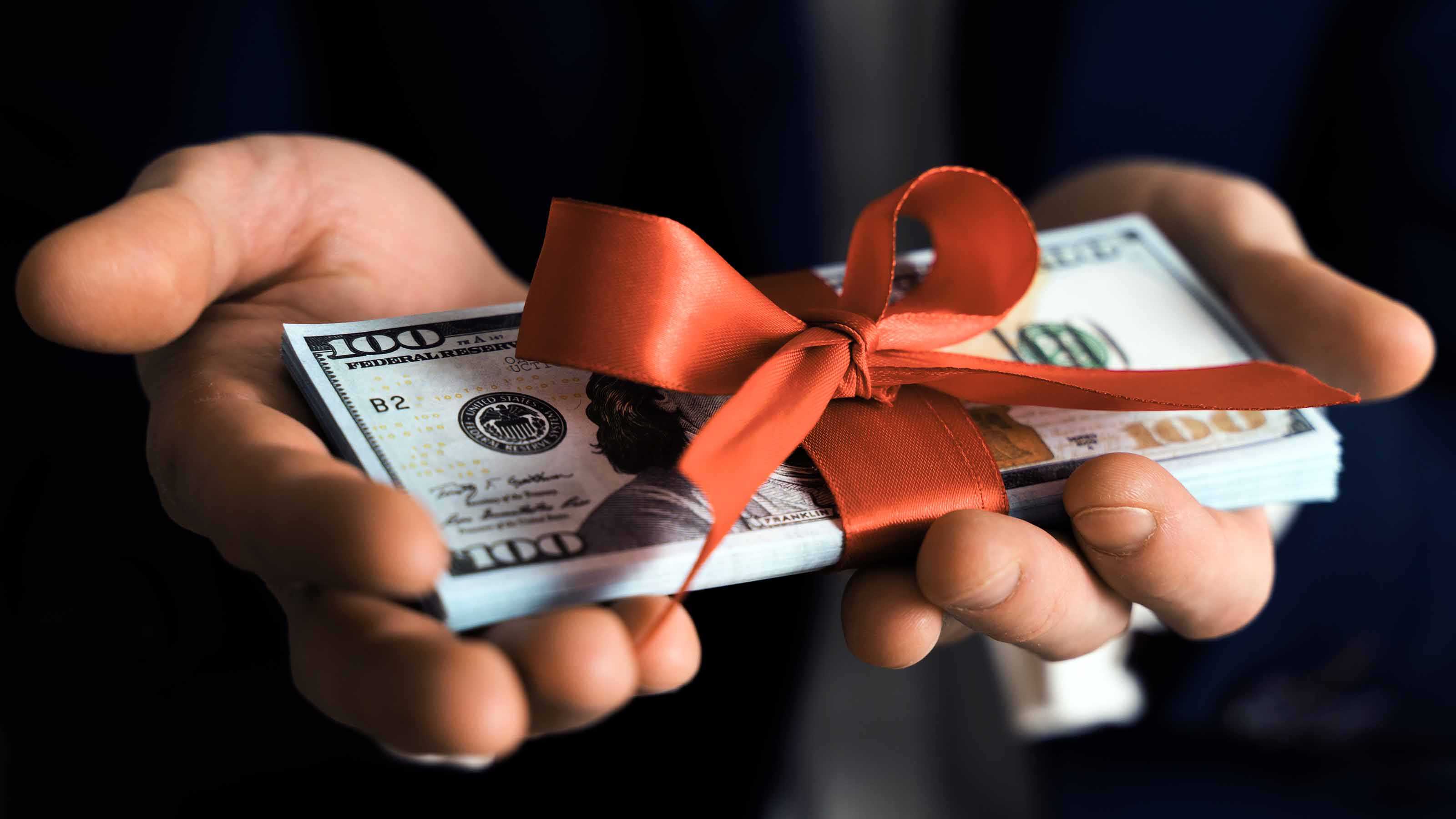Are Dividends on the Way Back?
There may be signs of life with increases in dividends from certain stocks.


Savers and investors have few causes for complaint. But one frustration is the sluggish pace and shrunken heft of dividend increases. Although U.S. companies have more than $2 trillion in cash, scads of firms that not long ago raised dividends by 10% a year have morphed into relative misers: The median annualized increase within the S&P 500 dwindled to 6% in the fourth quarter of 2023.
Look at ProShares S&P 500 Dividend Aristocrats (NOBL), an equal-weighted exchange-traded fund of 68 stocks with 25 consecutive years or more of raises. From 2015 to 2020, the fund hiked its payout by 11.5% a year. Since the start of 2021, that fell to 5.4%, limited by near-freezes from one-time cash spigots like Kimberly-Clark.
Apple is not an Aristocrat but clings to a habit of raising quarterly dividends each year by just a penny a share. UPS, soon to join the Aristocrats, also just hiked its payout by one cent a quarter.
From just $107.88 $24.99 for Kiplinger Personal Finance
Become a smarter, better informed investor. Subscribe from just $107.88 $24.99, plus get up to 4 Special Issues

Sign up for Kiplinger’s Free Newsletters
Profit and prosper with the best of expert advice on investing, taxes, retirement, personal finance and more - straight to your e-mail.
Profit and prosper with the best of expert advice - straight to your e-mail.
I asked around and got explanations — or excuses. One is that cash is so valuable, with interest rates up, that companies are hoarding it. Another is that a large cohort of CEOs expected a recession and refused to commit to high dividends that would be impossible to freeze or cut without an uproar.
And there is the ever-present fixation with buybacks despite a new 1% federal tax and the sky-high valuations of so many shares. Hence, the payout ratio — the percentage of earnings paid as cash dividends — has held at around 30% since the pandemic. It was 43% as recently as 2015 and 2016 and above 50% for much of the past 50 years.
Signs of a stock dividend comeback
As rates fall and cash yields eventually drop, tax-qualified dividend income will become relatively more valuable. Investors will press companies to pay up. Meta Platforms (formerly Facebook) chipped some ice with a first-time 50-cent quarterly dividend this year — hardly a gusher, as Meta is handing out just $5 billion a year from its $45 billion of free cash flow. Salesforce followed with a similar initial cash payout.
More encouraging: unexpectedly large early-2024 raises by old- timers such as Archer-Daniels-Midland (11.1%) and Sherwin-Williams (18.2%), as well as 25% from Exelon’s power-generation spin-off Constellation Energy. John Deere has been raising dividends twice a year, its latest pair of hikes totaling 17.6%. Walmart stepped up with a 9.5% raise. S&P Dow Jones Indices reports more increases and fewer cuts so far in 2024 than in the same months of 2023, though overall payouts are still creeping rather than leaping.
For a longer-term view, I consulted Dan Peris, who manages the Federated Hermes Strategic Value Dividend Fund and is to dividend literature what the late John le Carré was to spy novels. In a new book, The Ownership Dividend: The Coming Paradigm Shift in the U.S. Stock Market, Peris predicts that higher payout ratios are inevitable — his target is 50% — and insists “the bloom is off the buyback rose.” Competition from higher fixed-income yields will encourage fatter dividends.
But Peris also says that company bosses are revisiting the idea that shareholders should be partners in the business rather than adversarial share-sellers — and plying them with hard cash is central to this plan. Meta’s payout, he says, is a “green shoot” and “symbolic.” With a yield of 0.4%, Meta is not an income investment and may never be, but its move clears the way for other new-generation firms that are serious about growth but also aspire to average or above-average dividend yields. And that would be a breakthrough.
Note: This item first appeared in Kiplinger's Personal Finance Magazine, a monthly, trustworthy source of advice and guidance. Subscribe to help you make more money and keep more of the money you make here.
Related Content
Profit and prosper with the best of Kiplinger's advice on investing, taxes, retirement, personal finance and much more. Delivered daily. Enter your email in the box and click Sign Me Up.

Kosnett is the editor of Kiplinger Investing for Income and writes the "Cash in Hand" column for Kiplinger Personal Finance. He is an income-investing expert who covers bonds, real estate investment trusts, oil and gas income deals, dividend stocks and anything else that pays interest and dividends. He joined Kiplinger in 1981 after six years in newspapers, including the Baltimore Sun. He is a 1976 journalism graduate from the Medill School at Northwestern University and completed an executive program at the Carnegie-Mellon University business school in 1978.
-
 8 Ways to Declutter Your Life: Retirement 'Non-Resolutions'
8 Ways to Declutter Your Life: Retirement 'Non-Resolutions'Here's how to stop wasting your energy on things that don't enhance your new chapter and focus on the things that do.
-
 To Retire Rich, Stop Chasing Huge Returns and Do This Instead
To Retire Rich, Stop Chasing Huge Returns and Do This InsteadSaving a large percentage of your income, minimizing taxes and keeping spending in check can offer a more realistic path to retiring rich.
-
 New Year, New Retirement Rules: How to Keep Up With Changes
New Year, New Retirement Rules: How to Keep Up With ChangesFor a successful modern retirement, prepare for a longer life, manage high health care costs and prioritize your social life and purpose.
-
 8 Practical Ways to Declutter Your Life in 2026: A Retirement 'Non-Resolution' Checklist
8 Practical Ways to Declutter Your Life in 2026: A Retirement 'Non-Resolution' ChecklistHere's how to stop wasting your energy on things that don't enhance your new chapter and focus on the things that do.
-
 To Retire Rich, Stop Chasing Huge Returns and Do This Instead, Courtesy of a Financial Planner
To Retire Rich, Stop Chasing Huge Returns and Do This Instead, Courtesy of a Financial PlannerSaving a large percentage of your income, minimizing taxes and keeping spending in check can offer a more realistic path to retiring rich.
-
 New Year, New Retirement Rules: Here's How You Can Keep Up as the Landscape Changes
New Year, New Retirement Rules: Here's How You Can Keep Up as the Landscape ChangesFor a successful modern retirement, prepare for a longer life, manage high health care costs and prioritize your social life and purpose.
-
 Stocks End Volatile Year on a Down Note: Stock Market Today
Stocks End Volatile Year on a Down Note: Stock Market TodayAfter nearing bear-market territory in the spring, the main market indexes closed out the year with impressive gains.
-
 I’m 45 and I’ve Barely Invested in the Stock Market. I Recently Inherited $50,000. What Should I Do?
I’m 45 and I’ve Barely Invested in the Stock Market. I Recently Inherited $50,000. What Should I Do?What should you do with a big inheritance? We asked a financial expert for advice.
-
 A Contrarian Approach Pays Off for This Bond Fund
A Contrarian Approach Pays Off for This Bond FundThe Dodge & Cox Income Fund has outperformed in 2025 thanks to its managers' fearless approach.
-
 7 Outrageous Ways Retirees Can Invest Their Money in 2026
7 Outrageous Ways Retirees Can Invest Their Money in 2026Stocks and bonds aren't the only ways to invest your retirement "fun money."
-
 7 Creative Ways to Spend Less and Save More In Retirement, Courtesy of a Financial Pro
7 Creative Ways to Spend Less and Save More In Retirement, Courtesy of a Financial ProWorried you won't have enough money later in life? Try redesigning your vision of retirement, and you may find your savings go further than you thought.